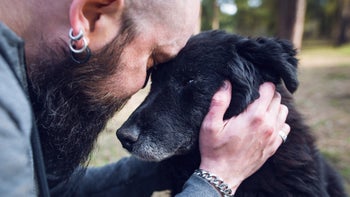
Capstar for Dogs: Get Rid of Fleas Fast
Key takeaways:
Capstar (nitenpyram) is a fast-acting flea treatment for dogs. Although Capstar works quickly, its benefits last just 24 hours.
Capstar is given to dogs as an oral tablet. The correct dosage for your dog will be based on their weight.
Most dogs experience few, if any, side effects from Capstar. When they do occur, the side effects may include itchiness, pacing, low energy, lack of appetite, or vomiting.
Table of contents

If you’ve ever dealt with a canine flea infestation, you have seen how quickly it can explode from “just a few fleas” to a completely overwhelming situation. Severe flea infestations take a toll on both dogs and their owners, so it’s important to address them as quickly as possible.
Historically, the only way to kill fleas fast was with a “flea dip.” But these topical treatments can have significant effects on both pets and people — in addition to being unpleasant.
Capstar (nitenpyram), a fast-acting flea treatment for dogs, offers similar benefits to a flea dip, but with less frustration and a lower risk of side effects. Below, we take a closer look at how Capstar for dogs works, its potential side effects, and more.
Search and compare options
Capstar for dogs at a glance
Common names | Capstar (nitenpyram) |
What it treats | Flea infestations |
How it comes (forms) | Tablet |
Common side effects | Itchiness, pacing, chewing on the skin; lethargy, decreased appetite, vomiting, and diarrhea |
Average cost |
What is Capstar for dogs, and how does it work?
Capstar is an oral medication that is FDA approved as a fast-acting flea treatment for dogs and puppies.
When a dog ingests a Capstar tablet, the medication is quickly absorbed into the bloodstream. It then circulates throughout the body and is ingested by the fleas feeding on the dog. Capstar affects the nervous system in adult fleas, causing the fleas to die.
Fleas begin to die within just 30 minutes of a dog taking a dose of Capstar, and almost all adult fleas are dead within 3 hours. This is in contrast to flea preventatives, which may take up to a day to kill all of the adult fleas on a dog.
Although it kills fleas quickly, Capstar only works against adult fleas. And it’s only effective for about 24 hours. So Capstar isn’t a replacement for regular flea prevention medications. Capstar provides rapid relief, while a long-acting preventative provides lasting flea control.
Capstar is also used to treat maggots in dogs. Open wounds exposed to the environment can become infested with maggots (fly larvae). Maggots feed on dead and dying tissue, and they can cause pain and inflammation. Maggots can be difficult to remove by hand due to their large numbers but Capstar effectively kills them.
How is Capstar given to dogs, and what is the typical dosage?
Capstar is available in two doses: 11.4 mg and 57 mg. The 11.4 mg dose is for dogs who weigh 2 lbs to 25 lbs. The 57 mg dose is given to dogs who weigh 25.1 lbs to 125 lbs. Give your dog the dose that corresponds to their weight, or consult with your veterinarian if you have questions.
Read more like this
Explore these related articles, suggested for readers like you.
Dogs can safely take Capstar once a day, if needed. In most cases, however, the medication is given as a one-time treatment to rapidly address a flea infestation. A long-acting flea preventative is then used for lasting flea control.
What are common side effects of Capstar in dogs?
Most of Capstar’s potential side effects are caused by the rapid dying off of a large number of fleas.
After a dose of Capstar, dogs may itch or chew on their skin. They may also pace, tremble, or show other signs of being uncomfortable. These side effects are caused by fleas becoming more excitable as they die. But they usually resolve within a few hours (once the fleas are dead).
A small number of dogs experience side effects directly related to the medication. The most commonly reported side effects of this type include:
If your dog experiences any of these side effects after taking Capstar, contact your veterinarian.
What are the most serious risks of Capstar for dogs?
Serious side effects related to Capstar are rare, but they can occur. For example, some dogs may experience an allergic reaction to Capstar. Signs of an allergic reaction may include:
Skin redness or swelling
Hives
Drooling
Though rare, neurological effects have also been reported in dogs receiving Capstar. These effects are more common when Capstar is inappropriately given to dogs who weigh less than 2 lbs or who are younger than 8 weeks old.
Neurologic effects related to Capstar may include:
Trembling
Incoordination
If your dog experiences an allergic reaction or neurological side effects after taking Capstar, seek veterinary care immediately.
Does Capstar interact with any other dog medications?
Capstar has no known interactions with other medications.
Capstar is often given in combination with long-acting flea preventatives. But talk to your veterinarian before doing so to ensure that you are combining the medications safely.
What should you do if your dog misses a dose of Capstar?
If you forget to give your dog a dose of Capstar, give them the medication as soon as you remember. Always wait 24 hours between Capstar doses, and never give your dog two doses at once.
The bottom line
Capstar (nitenpyram) is a safe and effective medication that is used to rapidly treat adult fleas in dogs. A single dose of the medication can rid a dog of fleas within just a few hours, providing quick relief from the effects of a flea infestation.
Capstar only kills adult fleas and does not prevent a dog from getting fleas again. Therefore, it’s important to combine Capstar with a long-acting flea preventative to provide lasting flea control for your pup.
Why trust our experts?



References
Boothe, D. M. (2014). Adverse drug reactions in the dog and cat. World Small Animal Veterinary Association World Congress Proceedings, 2014.
Cohen, A. (n.d.). Fleas. Cornell Richard P. Riney Canine Health Center.
Novartis Animal Health US, Inc. (n.d.). Capstar (nitenpyram) tablets.
Petiq, LLC. (n.d.). Capstar (nitenpyram) oral flea treatment for dogs - 6 doses.
Schenker, R., et al. (2002). Efficacy of nitenpyram (Capstar) against Ctenocephalides felis over the first three hours following treatment of cats. Veterinary Information Network.
Schenker, R., et al. (2003). Comparative speed of kill between nitenpyram, fipronil, imidacloprid, selamectin and cythioate against adult Ctenocephalides felis (Bouché) on cats and dogs. Veterinary Parasitology.
Sergeant's Pet Care Products LLC. (2023). Capstar - nitenpyram tablet [package insert].
Western College of Veterinary Medicine. (2021). Myiasis. University of Saskatchewan.





























